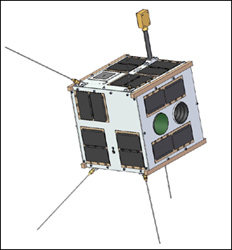A pair of space telescope satellites, designed by U of T Engineering’s Space Flight Laboratory (SFL), are now circling the Earth, prepared to find and study the brightest stars in the sky.
Measuring only 20 centimetres a side, and weighing less than seven kilograms, the nano-satellites are the smallest astronomical satellites ever built. They were launched February 25 from the Satish Dhawan Space Centre in Sriharikota, India. Funded by Austria, they are the first two components in the planned six-satellite BRIght Target Explorer (BRITE) mission.
One of the two satellites launched February 25 was also built at SFL while the other was built in Austria. Four more satellites are planned for BRITE, two to be funded by Poland and the final two by the Canada Space Agency, said Cordell Grant, Manager of Satellite Systems for the Space Flight Laboratory. Each twin in a pair watches the sky in a different colour (red or blue), providing another layer of data to the scientists.
Grant said that so far the satellites are working fine. “It was nerve-wracking watching the launch because something can always go wrong. I felt great when it launched successfully, and I felt even better a few hours later when we actually ‘talked’ to the satellites and ensured they were both working.”
“We demonstrated that nano-satellites can be developed quickly, by a small team and at a cost that is within reach of many universities, small companies and other organizations,” Grant said. “A nano-satellite can take anywhere from six months to a few years to develop and test, but we typically aim for two years or less.”

Until now, such nano-satellites had been used only to monitor the earth and experiment with new technologies. “Researchers, scientists and companies worldwide, who have great ideas for space-borne experiments, but do not have the means to fund a large spacecraft, can now see their ideas realized,” said Grant. “BRITE has the potential to open an entirely new market for low-cost high-performance satellites.”
The Space Flight Laboratory is responsible for operating the satellites during the commissioning phase, which is expected to last a couple of months, Grant said. Operation of the satellites will then gradually be transferred to Austria.
BRITE is the first nano-satellite mission intended for astronomy, and the first-ever astronomy constellation – more than one satellite working toward a common objective – of any size. The previous world-record holder for small astronomy satellites was the MOST satellite, designed and assembled in part by the Space Flight Laboratory. Launched in 2003 and still operating, MOST was the first entirely Canadian satellite for astronomy, weighing in at 53 kilograms. Compared to the 11 metric tons of the Hubble Space Telescope, MOST was aptly called a micro-satellite.

“BRITE is expected to demonstrate that nano-satellites are now capable of performance that was once thought impossible for such small spacecraft,” said Grant. But only small telescopes can fit within a 20 centimetre cube. Therefore, BRITE is not intended to take pretty pictures, but will simply observe stars and record changes in their brightness over time. Such changes could be caused by spots on the star, a planet or other star orbiting the star, or by oscillations and reverberations within the star itself – the analogue of earthquakes on stars. The study of these so-called “starquakes” is called asteroseismology.
To perform precise measurements of the brightness of stars, the telescopes need to be above the atmosphere. Otherwise, scintillation — the atmospheric effect that causes stars to twinkle – overwhelms the relatively small brightness variations of the stars themselves. By avoiding this, a very small telescope in space can produce more accurate data than a much larger telescope on the ground. Also, unlike telescopes on Earth which are useless during the day, in bad weather or when the stars set below the horizon, telescopes in space can potentially observe stars all the time.
[youtube https://www.youtube.com/watch?v=8eh5cu5tys4]
As their name suggests, the BRITE satellites will focus on the brightest stars in the sky including those that make up prominent constellations like Orion the Hunter. These stars are the same ones visible to the naked eye, even from city centres. Because very large telescopes mostly observe very faint objects, the brightest stars are also some of the most poorly studied stars.
It turns out that the brightest stars are also the largest. Big bright stars lead short and violent lives and deaths (supernovas) and in the process seed the universe with heavy elements without which life on Earth would be impossible. To better understand these stars is to better understand how life arose on our planet, Grant said.



